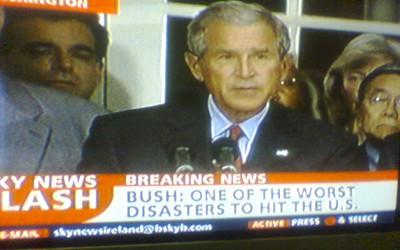17.3 Crisis Communication Plan
Learning Objective
- Understand how to prepare a crisis communication plan.
A rumor that the CEO is ill pulls down the stock price. A plant explosion kills several workers and requires evacuating residents on several surrounding city blocks. Risk management seeks to address these many risks, including prevention as well as liability, but emergency and crisis situations happen nevertheless. In addition, people make errors in judgment that can damage the public perception of a company. The mainstream media does not lack stories involving infidelity, addiction, or abuse that require a clear a response from a company’s standpoint. In this chapter we address the basics of a crisis communication plan.
Figure 17.2
Crisis communication requires efficiency and accuracy.
Danny Howard – Bush: Worst Disaster – CC BY-NC 2.0.
Focus on key types of information during an emergency: (Mallet, L., Vaught, C., and Brinch, M., 1999)
- What is happening?
- Is anyone in danger?
- How big is the problem?
- Who reported the problem?
- Where is the problem?
- Has a response started?
- What resources are on-scene?
- Who is responding so far?
- Is everyone’s location known?
You will be receiving information from the moment you know a crisis has occurred, but without a framework or communication plan to guide you, valuable information may be ignored or lost. These questions help you quickly focus on the basics of “who, what, and where” in the crisis situation.
Developing Your Crisis Communication Plan
A crisis communication plan is the prepared scenario document that organizes information into responsibilities and lines of communication prior to an event. With a plan in place, if an emergency arises, each person knows his or her role and responsibilities from a common reference document. Overall effectiveness can be enhanced with a clear understanding of roles and responsibilities for an effective and swift response.
The plan should include four elements:
- Crisis communication team members with contact information
- Designated spokesperson
- Meeting place/location
- Media plan with procedures
A crisis communication team includes people who can
- decide what actions to take,
- carry out those actions,
- offer expertise or education in the relevant areas.
By designating a spokesperson prior to an actual emergency, your team addresses the inevitable need for information in a proactive manner. People will want to know what happened and where to get further details about the crisis. Lack of information breeds rumors, which can make a bad situation worse. The designated spokesperson should be knowledgeable about the organization and its values; be comfortable in front of a microphone, camera, and media lights; and be able to stay calm under pressure.
Part of your communication crisis plan should focus on where you will meet to coordinate communicate and activities. In case of a fire in your house, you might meet in the front yard. In an organization, a designated contingency building or office some distance away from your usual place of business might serve as a central place for communication in an emergency that requires evacuating your building. Depending on the size of your organization and the type of facilities where you do business, the company may develop an emergency plan with exit routes, hazardous materials procedures, and policies for handling bomb threats, for example. Safety, of course, is the priority, but in terms of communication, the goal is to eliminate confusion about where people are and where information is coming from.
Whether or not evacuation is necessary, when a crisis occurs, your designated spokesperson will gather information and carry out your media plan. He or she will need to make quick judgments about which information to share, how to phrase it, and whether certain individuals need to be notified of facts before they become public. The media and public will want to know information and reliable information is preferable to speculation. Official responses help clarify the situation for the public, but an unofficial interview can make the tragedy personal, and attract unwanted attention. Remind employees to direct all inquiries to the official spokesperson and to never speak “off the record.”
Enable your spokesperson to have access to the place you indicated as your crisis contingency location to coordinate communication and activities, and allow that professional to prepare and respond to inquiries. When crisis communication is handled in a professional manner, it seeks not to withhold information or mislead, but to minimize the “spin damage” from the incident by providing necessary facts, even if they are unpleasant or even tragic.
Key Takeaway
Because crises are bound to happen despite the best planning, every organization should have a crisis communication plan, which includes designating a crisis communication team and spokesperson.
Exercises
- Locate the crisis communication plan where you go to school or work, or find one online. Briefly describe the overall plan and please note at least one part, element, or point of emphasis we have not discussed. Post and compare with classmates.
- When people don’t know what to do in a crisis situation, what happens? How can you address probable challenges before the crisis occurs? Discuss your ideas with classmates.
- As a case study, research one crisis that involves your area of training or career field. What communication issues were present and how did they affect the response to the crisis? Compare your results with classmates.
- Locate a crisis communication online and review it. Share and compare with classmates.
- Do you always have to be on guard with members of the media? Why or why not? Explain your answer to the class as if they were members of the media.
References
Mallet, L., Vaught, C., & Brinch, M. (1999). The emergency communication triangle. Centers for Disease Control and Prevention, National Institute for Occupational Saftey and Health, U.S. Department of Health and Human Services. Pittsburgh, PA: Pittsburgh Research Laboratory.


